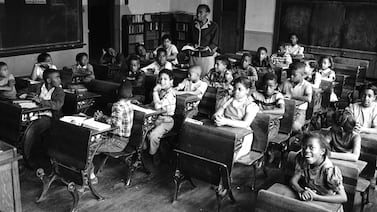Become a Chalkbeat sponsor
Brown v. Board of Education
On the 70th anniversary of Brown v. Board of Education, a look at how the milestone Supreme Court decision affects schools, students, teachers, and communities today.
For 40 years, Philadelphia was under a court order to desegregate its schools.
‘Did you say segregation ended?’ My student’s question speaks to the reality inside classrooms.
Since 1965, Fayette County schools have been operating under a desegregation order. Some worry that without court oversight, the system will resegregate.
Representing families challenging school segregation, here’s what the NAACP’s chief legal counsel told the high court.
American schools are far more integrated than they were before Brown v. Board. But 70 years after the decision, segregation is increasing in the large districts that serve many Black students.
Black-white segregation rate is three times the national average
New York City teens are taking to the streets and meeting with top officials to demand more action on school integration.
Whether it continues a commitment to student equity now depends solely on the collective will of a school board that could change with a single election cycle.
Linda Brown, whose name became part of American history through the Brown v. Board of Education case, died Sunday. She became the center of the legal and political battle to integrate U.S. schools after she was denied access to an all-white school down the street in Topeka, Kansas in 1950. Her father and several
This is true even as Indiana sees a growing share of non-white students. IU conducted the study along with the Civil Rights Project at UCLA.
This racialized concentration of school poverty creates a persistent achievement gap, and it must stop. Now.
Chalkbeat, the Indianapolis Star and WFYI are teaming up to examine why inequality and segregation continue in Indianapolis 60 years after Brown vs. Board of Education.












